

How 3D Printing The Human Body Works [Infographic] Bioprinting - WFIRM - Wake Forest Baptist Medical Center. Living tissues are composed of many cell types that are all arranged in a very specific order in three-dimensional space.
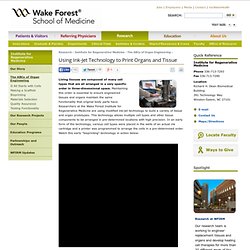
Maintaining this order is essential to ensure engineered tissues and organs maintain the same functionality that original body parts have. Researchers at the Wake Forest Institute for Regenerative Medicine are using modified ink-jet technology to build a variety of tissue and organ prototypes. This technology allows multiple cell types and other tissue components to be arranged in pre-determined locations with high precision. Organovo. University Biofabrication Lab. Biofabrication uses cells or biologics as basic building blocks in which biological models, systems, devices and products are manufactured.
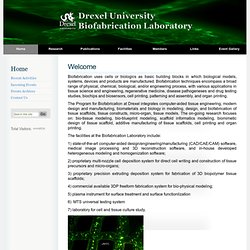
Biofabrication techniques encompass a broad range of physical, chemical, biological, and/or engineering process, with various applications in tissue science and engineering, regenerative medicine, disease pathogeneses and drug testing studies, biochips and biosensors, cell printing, patterning and assembly, and organ printing. The Program for Biofabrication at Drexel integrates computer-aided tissue engineering, modern design and manufacturing, biomaterials and biology in modeling, design, and biofabrication of tissue scaffolds, tissue constructs, micro-organ, tissue models. First Commercial 3-D Bioprinter Fabricates Organs To Order. The problem with organ transplants is that the organ has to come from someone else.

Since most people rather fancy their hearts and lungs, getting any organ other than a kidney usually requires the difficult combination of donor consent and timely death. In an attempt to circumvent that limitation, the engineering company engineering firm Invetech teamed up with the medical company Organovo to produce the first commercial 3-D bio-printer. The device, which works like a 3-D fabricator, builds organs up one layer of cells at a time. Instead of using melted plastic or ink, the printer uses different cells based on the recipient's own body, thus significantly lowering the chance of organ rejection. 3D Systems Unveils 3D Printed Bespoke Back Brace to Treat Chronic Scoliosis. One of the most important parts of growing up, from a child’s point of view, is blending in with their peers.
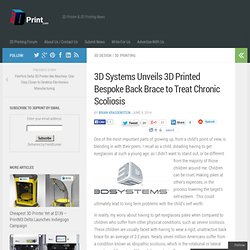
I recall as a child, dreading having to get eyeglasses at such a young age, as I didn’t want to stand out, or be different from the majority of those children around me. Children can be cruel, making jokes at other’s expenses, in the process lowering the target’s self-esteem. This could ultimately lead to long term problems with the child’s self worth. In reality, my worry about having to get eyeglasses pales when compared to children who suffer from other physical conditions, such as severe scoliosis. In China, world’s first successful 3D-printed shoulder and collar bone implants. Jun 3, 2014 | By Cynthia In Xi'an, China, the capital of Shaanxi province, 3D-printed titanium prostheses were successfully implanted into three patients suffering from cancerous bone tumors.

The procedures took place on March 27 and April 3 and the patients are currently in good condition and recovering with their new, 3D-printed bone replacements: a collar bone, a shoulder bone, and the right ilium of the pelvis. One of the three patients, a 20-year-old woman, was diagnosed a year ago with Ewing's sarcoma in her right collar bone. New 3D cartilage printing technology could combat Osteoarthritis. April 28, 2014 Causing severe pain and loss of mobility in joints such as knees and fingers, Osteoarthritis is the most common joint disorder in the world.
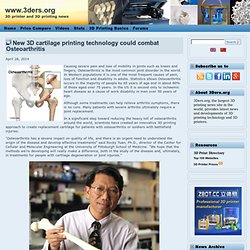
In Western populations it is one of the most frequent causes of pain, loss of function and disability in adults. Statistics shows Osteoarthritis occurs in the majority of people by 65 years of age and in about 80% of those aged over 75 years. In the US it is second only to ischaemic heart disease as a cause of work disability in men over 50 years of age. Although some treatments can help relieve arthritis symptoms, there is no cure. In a significant step toward reducing the heavy toll of osteoarthritis around the world, scientists have created an innovative 3D printing approach to create replacement cartilage for patients with osteoarthritis or soldiers with battlefield injuries. Organovo's First Fully Cellular 3D Bioprinted Liver Tissue - 3d printing.
At the 2013 Experimental Biology conference in Boston, Organovo, a company specialised in bioprinting, presented the first fully cellular 3D bioprinted liver tissue.
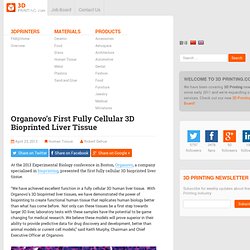
“We have achieved excellent function in a fully cellular 3D human liver tissue. With Organovo’s 3D bioprinted liver tissues, we have demonstrated the power of bioprinting to create functional human tissue that replicates human biology better than what has come before. Not only can these tissues be a first step towards larger 3D liver, laboratory tests with these samples have the potential to be game changing for medical research. We believe these models will prove superior in their ability to provide predictive data for drug discovery and development, better than animal models or current cell models,” said Keith Murphy, Chairman and Chief Executive Officer at Organovo. Breakthrough: 3D printer creates artificial human tissue. April 4, 2013 Oxford University scientists have developed a custom-built programmable 3D printer that can create materials with several of the properties of living tissues.

The new type of material consists of thousands of connected water droplets that are encapsulated within lipid films, which can perform some of the functions of the cells inside our bodies. Scientists say these printed 'droplet networks' could be the building blocks of a new kind of technology for delivering drugs to places where they are needed, or potentially one day replacing or interfacing with damaged human tissues. "We aren't trying to make materials that faithfully resemble tissues but rather structures that can carry out the functions of tissues," said Professor Hagan Bayley of Oxford University's Department of Chemistry, who led the research.
"We've shown that it is possible to create networks of tens of thousands connected droplets. (Credit: Oxford University/G Villar) CAD/CAM Corner - Implantable Cartilage Created With Hybrid 3D Printer. Home. Printing body parts: Making a bit of me. 5 Discoveries That Will Change The Future of Organ Transplants. Although the concept is still experimental, researchers have shown that it may one day be possible to use 3D printing to create replacement tissues and organs.
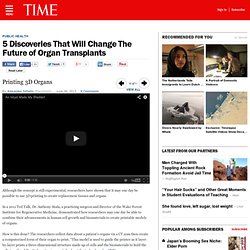
In a 2011 Ted Talk, Dr. Anthony Atala, a practicing surgeon and director of the Wake Forest Institute for Regenerative Medicine, demonstrated how researchers may one day be able to combine their advancements in human cell growth and biomaterials to create printable models of organs. How is this done? The researchers collect data about a patient’s organs via a CT scan then create a computerized form of their organ to print. The Army's Bioprinted Skin Is Almost Ready to Be Used on Soldiers. The US Army is hoping to soon begin clinical trials with 3D-printed skin.
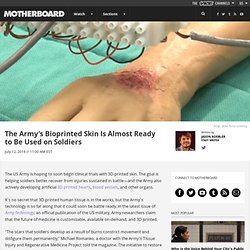
The goal is helping soldiers better recover from injuries sustained in battle—and the Army also actively developing artificial 3D printed hearts, blood vessels, and other organs. It's no secret that 3D-printed human tissue is in the works, but the Army's technology is so far along that it could soon be battle ready.
In the latest issue of Army Technology, an official publication of the US military, Army researchers claim that the future of medicine is customizable, available on-demand, and 3D printed. Neurosurgeons Are 3D Printing - Fabbaloo Blog - Fabbaloo. A Pen That 3-D Prints Bone Right Onto Patients. 3DPrinting: Bioprinting organs/human tissue cells. Archives for the category: Bioprinting organs/human tissue cells April 24, 2014 3D printer helps make synthetic skin tissue. Transform medical 2D CT or MRI data into usable 3D models. We ran across an interesting video that talks about Materialise's ventures into the medical manufacturing space.
We've posted about medical uses of 3D print tech before, but Materialise specializes in this niche, and have for quite some time. Materialise produces 3D software specifically designed for this market: Mimics, which can transform medical 2D CT or MRI data into usable 3D models. From those models prosthetics or other medical implants can be derived. In the video you'll see students using the software to design a prosthetic leg for Cassidy the dog. How popular is this approach? Via YouTube. Chinese scientists uses 3D printer to print ear. Jul.9, 2012 In Nanjing Baoyan Automation Co., Ltd. Fingers Restored By 3D Scanning - Fabbaloo Blog - Fabbaloo. Did you ever take a very close look at your fingers? They are incredibly complex machines, with not only shape and texture, but also motion. Imagine if fate caused the loss of one or more of them? There are solutions today, such as those produced by Didrick Medical, who make a kind of finger-harness that fits over the hand and implements an "active-function artificial finger prostheses".
The design permits a variety of finger loss scenarios to be resolved. This is their "X-Finger" product. But the problem is in the build. Didrick Medical's approach is to custom design each and every X-Finger to perfectly match the recipient. Enter 3D Laser Scanning from GKS Global Services, who used their equipment and software to gather the necessary 3D modelling data much more quickly than had been done manually. Once the 3D model is successfully captured and tweaked, SolidWorks takes over and the production process continues as normal. Via LaserDesign. 3D model of a finger bone. New Scientist reports on a medical breakthrough using 3D printing: exact replicas of finger bones have been produced. Christian Weinand of Berne Switzerland has been testing a new technique in which a 3D model of a finger bone is fed into a 3D printer, and an exact duplicate is printed.
By using a suitable print medium (in this case "tricalcium phosphate and a type of polylactic acid - natural structural materials found in the human body") the resulting artificial bone can be inserted into the body and take over for the failed bone. Weinand says: In theory, you could do any bone. 83 year-old woman got 3D-printed mandible. Who Needs a Bioprinted, Animal Hybrid Organ Transplant? Using 3D microdroplet printing scientists build synthetic cells and tissues. BioHacking Leads to 3D BioPrinting? Bioprinting. Medical 3D printing.